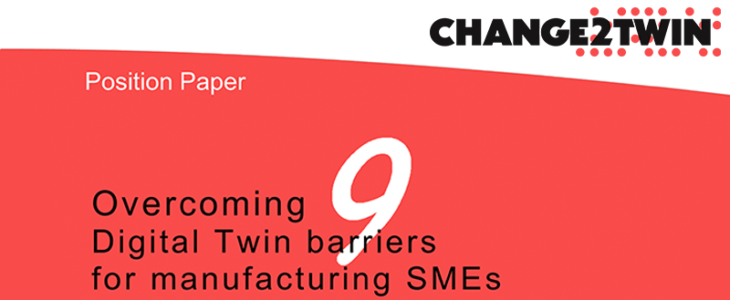
Change2Twin project has just released a new position paper “Overcoming nine digital twin barriers for manufacturing SMEs”. The paper analyses the most common challenges that companies face and recommends how to overcome them.
For many small and middle-sized companies, the idea of acquiring a digital twin sounds like an unrealistic scenario. Many immediately think of the financial and technical barriers that would prevent them from starting such a project. But in fact, there are organisational aspects that could be taken into consideration. Overcoming them, a reliable digital twin becomes more attainable than first imagined.
9 major barriers to overcome
The multi-national expert team, led by Paolo Pileggi (TNO), collaborating in the Change2Twin project, summarises critical problems that companies are facing and published their findings in a new position paper. The authors highlight nine major barriers of technological and organisational nature, collected from experience and discussions with manufacturing SMEs over the past few years. “It is not surprising that companies tend to focus more on the affordability and technical complexity of the digital twin solution. But often it is a different aspect that undermines the successful adoption of a digital twin. For example, neglecting the state-of-the-art digitalisation solutions in companies leads to a digital gap and loss of competitiveness. We wrote this paper to point at the most common barriers and offer companies some mitigating strategies,” says Pileggi.
The paper primarily addresses manufacturing SMEs but, at the same time, it is intended for technology providers, as well as consultants and digitalisation stakeholders at local and (inter)national levels. Providers of digital twin solutions should become aware of the problems their customers may face. This paper helps understand the challenges better and consider them in their offerings. Stakeholders, especially Digital Innovation Hubs, can use these findings to enhance their consulting services and provide solutions that focus on their specific manufacturing clients’ needs.
The paper is available to download for free here:
Authored by: Paolo Pileggi, (TNO, Netherlands), Armir Bujari (University of Bologna, Italy), Oliver Barrowclough (SINTEF, Norway), Jochen Haenisch (Jotne, Norway), Robert Woitsch (BOC-EU, Austria).
About Change2Twin
Change2Twin is an EU-funded project (part of I4MS), which promotes a broader acceptance of digital twins among manufacturing SMEs and mid-caps through a unique support scheme. It cooperates with local DIHs, technology providers and related European projects. The scheme reaches from analysing a company’s digitisation potential and individual mentoring plan, to a ready-to-use recipe for digital twin deployment. The project provides companies with funding that covers the assessment of their readiness and fitness for digital twinning, as well as the actual deployment of the digital twin, including application experiments.
The project has received funding from the European Union’s Horizon 2020 Research and Innovation Programme under Grant Agreement No. 951956. The project runs from June 2020 until May 2024.


